|
Spectroscopic, Photometric, and Computational Analysis of B-Type Stars in M45: Gaia DR3 Radial Velocity Discrepancies Timothy Winans, Howard Community College, University of Maryland Baltimore County Mentored by: Kenny A. Diaz Eguigure, M.S. |
Abstract
Pleaides, or Messier 45 (M45) is a group of stars located in the constellation of Taurus. The scientific field of astronomy is primarily the observation and measurement of the electromagnetic spectrum (EMS) to obtain information about the intrinsic properties and evolutionary states of stars. For ground-based astronomy the only accessible portions of EMS are visible light which humans have evolved to sense such as the light on a computer screen, and the near-infrared. This research involved the collection of ground-based visible and near-infrared data on 9 bright “Naked eye” stars in M45. This involved the collection of spectroscopic data which is when the EMS is split into its constituent elements to determine the chemical information inside of the light. Photometric data is the measurement of the intensity or brightness of an objects EMS. Spectroscopic and photometric scientific data are represented through numerical values which can be further processed using advanced computational methods. 9 B-Type stars in M45 were targeted for ground-based spectroscopic and photometric observation. Spectral analysis at ≈ 4.2 × 10^2 nm – 7.4 × 10^2 nm indicated the presence of strong hydrogen Balmer absorption lines (Hα, Hβ, Hγ, Hδ) in observed line strengths and spectral slopes consistent with theoretical models and previous observations of early main sequence stars. Results of Isochrone fitting of M45 were consistent with contemporary stellar evolutionary models for B-type stars. GAIA DR3 data on the 9 B-Type stars was queried and calculated for comparison using Astropy and NumPy to derive stellar properties for 7 of the 9 targeted B-type stars. Discrepancies were observed between existing published radial velocities in SIMBAD for Merope (23 Tau) and Electra (17 Tau), and the calculated radial velocities derived from GAIA DR3 data.
Introduction
Galaxies have been observed since antiquity and cataloged since the late 17th century by a French astronomer and comet hunter named Charles Messier [1]. Messier catalogued objects that were fixed in the sky (including what we now know are galaxies nebulae and star clusters) to be avoided in the observations of comets. One of these was Messier 45 (M45) for short, also known as the Pleiades, and is a young bound open star cluster [2]. M45 has a long history in the study of stellar evolution, contributing to early observations that supported the empirical relationship between a star’s temperature and luminosity [3]. This discovery revealed a pattern in which most stars fall along a sequence where hotter blue stars shine brighter, while cooler red stars are dimmer [4]. This enabled the classification of stars based on their evolutionary stage, which is termed as a spectral classification. This spectral classification encompasses O, B, A, F, G, K, M where O type stars are Blue and hottest (≈30,000-50,000 K) and M type stars are Red, and coolest (≈2,500-3,700 K). This is known as the Main Sequence (MS), MS stars consist of ≈ 90% of all stars in the observable universe [5].
MS stars undergo nuclear fusion in which hydrogen burns in the nuclear process of converting the hydrogen into helium in the stars’ core. When the hydrogen is completely expended MS stars undergo diverging stellar evolution based on their solar mass which is an absolute value based on the mass of Earth’s Sun which is 1 M☉ unit of solar mass. The larger the mass of a star the quicker it expends all its hydrogen. O and B type stars’ lifespans can be only a few million years, whereas K and M type stars’ lifespans are typically tens of billions to trillions of years. When B-type stars expend their hydrogen, their evolution diverges depending on their solar mass, if their solar mass is ≈ < 8-10 M☉ they typically explode as supernovae becoming either a neutron star, or a black hole. Lower-mass B-type stars ≈ > 8 M☉ may evolve into white dwarfs instead of undergoing core collapse, remaining on the MS along with F, G, K, and M type stars for billions to trillions of years. Comparatively, High-mass B-Type stars theoretically quickly evolve off the MS after undergoing gravitational collapse [6].
Uncertainties remain in the stellar evolution and formation of B-type stars in M45, such as their mass distribution, early evolution, and role in cluster dynamics. The observed mass segregation in the Pleiades challenges aspects of stellar formation models, such as whether massive stars migrate inward due to dynamical interactions or if they are formed in situ.
Additionally, discrepancies in distance measurements from Hipparcos and GAIA have complicated efforts to refine stellar evolution tracks, which are needed to understand how
B-Type stars transition off the MS [7]. Likewise, questions have been raised about the lack of expected lithium present in lower-mass M45 stars suggesting models of convective mixing may be incomplete [8]. This could have broader implications for nucleosyntheses, which is the process of stellar evolution in which remnants of stars that deplete their hydrogen eventually become other stellar objects [9].
By investigating stellar properties and formation histories of B-Type stars in M45, this research aims to address these gaps and refine our understanding of early stellar evolution in open clusters. To do this, we collected spectroscopy data for 9 B-type stars in M45, stellar properties can be determined by astronomical spectroscopy, in which light is dispersed into its individual wavelengths to form a spectrum. This occurs when an electron absorbs a photon, gaining energy and transitioning to a higher energy level, called excitation, which creates absorption lines in the spectrum. When an electron transitions to a lower energy level, it emits a photon, producing an emission line in the spectrum, revealing a star’s temperature, luminosity, mass, radial velocity, and composition. The current way to collect astronomical spectrographs are charge-coupled devices (CCDs). [10].
We analyzed data collected by GAIA, a European Space Agency astronomical observatory mission to make the most detailed and accurate 3-dimensional map of the Milky Way. As part of their mission to generate a three-dimensional map of stars, the European Space Agency’s GAIA mapped motions, luminosity, temperature and composition. This effort has catalogued an unprecedented amount of baryonic matter and has produced an historic amount of data on stellar properties. Baryonic matter is all the matter in the universe that consists of protons, neutrons, and electrons. One aspect of GAIA data that requires further verification is the observation of bright B-type stars. Stellar brightness is known as magnitude, which is measured inversely where brighter objects have small or negative values and dimmer objects have larger values. The GAIA’s data set is considered complete for fainter stars within the magnitude range of G = 12 to G =17, the dataset for brighter stars (G < 7) contains gaps and incomplete observations. This is attributed to the over-saturation of GAIA Charge-coupled device (CCD) detectors that were designed to be optimized for fainter harder to detect stars.
The goal of our research is to compare data collected from our survey of B-type stars from M-45 to the data collected from GAIA DR3 to model and to use the data to predict the stellar evolution of M45. Through the investigation of B-type stellar properties, we hope to better understand and predict their role in stellar evolution and formation processes in M45.
Methods
Target Selection
Nine B-type stellar members in M45 were selected for spectroscopic and photometric imaging. All the data from is from the GAIA DR3 dataset shown by the unique identifier, except for Alcyone (eta Tau) which has a unique GAIA DR2 identifier. The exclusion of Alcyone (eta Tau) from the GAIA DR3 data set was not known prior to observations being conducted. The target stars were selected based on their stellar proximity, apparent magnitude and spectral type. Consideration was given to stars that would have optimal placement in the sky during the observation periods to maximize visibility, minimize atmospheric interference, and ensure alignment with instrumental constraints. Consideration was given to factors including the targets’ right ascension, declination, and altitude at the time of observation.
Observation Planning & Preliminary Procedures
After target selection, preliminary observation procedures that were conducted included assessing the equipment through initial observations and detailed analysis of equipment capabilities. Data gathering was limited to the correct combination of optimal sky conditions, weather conditions, and lunar phases. During preliminary observation sidereal times were calculated to track the rotation of the Earth relative to the stars. This is necessary to plan for the optimal time in observing M45 during culmination, to reduce atmospheric distortion and maximize signal-to-noise ratio.
Observations were conducted on the nights of March 29, May 15, September 12, and October 10, 2024. The equipment used was a Sharpstar 150-28HNT Hyperbolic Newtonian Reflector, ZWO 1600mm Pro for the main camera, ZWO AM5 Harmonic for the mount, and an ASI Air Plus for the CPU. The telescope configuration of the Sharpstar 150-28HNT Hyperbolic Newtonian Reflector had an f/stop of f/2.8, and the Shelyak Star Analyzer (SA) 200 for the spectrograph. The SA-200 transmission grating has 2.0 x 102 lines/mm in a close-coupled optical configuration which can provide high spectral resolution with minimal system errors. This configuration enables the observation of spectra in the visible to near-infrared range between 4.23 × 10 Å − 7.4 × 103 Å 𝑜𝑟 𝑐𝑜𝑛𝑣𝑒𝑟𝑡𝑒𝑑 𝑛𝑎𝑛𝑜𝑚𝑒𝑡𝑒𝑟𝑠 4.2 𝑥 102 𝑛𝑚 – 7.4 𝑥 102 𝑛𝑚. The main camera was cooled to –20 degrees Celsius and had a gain of 139.
The observatory used in this study (referred to as the HCC rooftop laboratory) is located on the roof of Howard Community College’s Science, Engineering, and Technology (SET) building. The sky surrounding Howard Community College (HCC) typically measures class 7 on the Bortle scale, which is indicative of high light pollution (Monterroza, et al, 2024). To test the calibration and data quality of the spectrographic imaging. The star Regulus (alf Leo) was targeted on May 5th, 2024, at the HCC rooftop observatory. The cropped spectra of Regulus is shown in (Figure 1), and its spectra was analyzed using R-SPEC software shown in (Figure 2).

Figure 1: Cropped Regulus Spectra (May 5th, 2024)
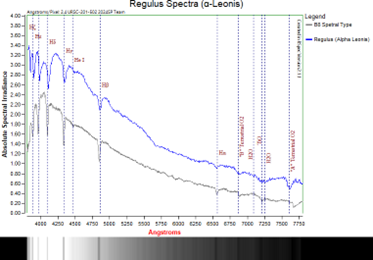
Figure 2: Regulus Spectrum (Blue), B8 Spectral type model (Gray).
Clear and sharp Balmer lines in Regulus’s spectrum were observed shown as the blue line representing our collected data in (Fig. 2), indicative of high-resolution spectra data. This includes the presence of Hydrogen beta (Hβ) at ≈ 4861 Å presenting as a well-defined dip with clear line wings. The presence of Hydrogen alpha (Hγ) at ≈ 4341 Å also presents as a sharp and distinct dip in Regulus’s spectra data. The observation of the alignment of spectral features Hβ, Hγ, Hδ to their expected position in Å provided evidence of wavelength calibration [11]. Close alignment with the B8 reference spectrum indicated the absence of any obvious instrumental or processing artifacts was noted, along with the close alignment with the B8 reference spectrum [12]. This close alignment between observational collected data (Blue) and reference data (Gray) of Regulus is consistent with its classification as a B-8 star. The observed line profiles show relatively narrow wings which are consistent with the expected rotation and temperature of a B8 star. No excessive broadening is visible in the spectrum, which indicates instrumental effects such as slit or detecting broadening are minimal [13].
Raw Spectra Image Processing
The raw spectra images were cropped and manually rotated using the GNU Image Manipulation Program (GIMP) an open-source program similar to Adobe Photoshop, and Windows photos [14]. This was conducted to resolve the individual spectra of each star for detailed analysis illustrated shown in (Fig. 1).
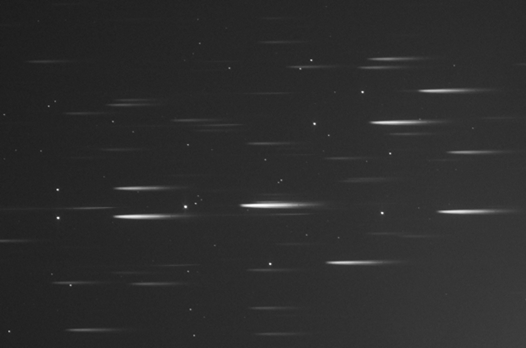
Figure 3: Non-Cropped Spectra of M45 Fall 2024
R-SPEC Software
R-Spec Software developed by Field Tested Systems LLC was used to process the spectroscopy data. The spectra images are loaded into R-SPEC, the background noise is subtracted, and the data is calibrated from pixels to angstroms. The spectrum is then cut to exclude all data between 4000 < Å and < 7500 Å, which removes data not within the visible to near-infrared range. Further processing was done for instrument response calibration through the creation of an R-SPEC Dat file. The data is then divided by the instrument calibration Dat file using the R-SPEC Math on 2 series, which yields the final calibrated spectra data as shown in (Fig. 2) [15].
Astropy GAIA query and NumPy Calculations
Astropy is a widely used open-source astronomy and scientific computing program that runs on the Python programming language [16]. NumPy is an array programming library that runs on the Python programming language and allows complex mathematical operations to be performed on data. The use of Astronomical Data Query Language (ADQL) with Astroquery which is part of the Astropy software ecosystem allows the direct retrieval of data from the GAIA Data Processing and Analysis Consortium (DPAC) [17].
Blind Astrometric Calibration
Observational targets were confirmed using blind astrometric plate solving through the uploading of images to astrometry.net without providing it with any additional reference [18]. The results showed all 9 targets were in the telescope’s field of view. An anomaly appeared in our images that we were able to characterize and eliminate from our data. Using ImageJ software to analyze the pixels it was determined it was likely an imaging artifact.
Results
B6 spectral type
The spectra of targeted B6 stars Electra (17 Tau), Merope (23 Tau), and Taygeta (q Tau) were captured on two separate observation sessions (Figs. 4 and 5). In both observational data sets Electra, Merope, and Taygete display absorption lines from the Hydrogen Balmer series, including Hβ and Hγ dips. This is consistent with their classification as B6 stars, displaying an expected gradual decrease in relative flux, a measure of the intensity of light from an astronomical object compared to a reference value, which was observed towards shorter wavelengths in the blue part of the spectrum [19]. The Hydrogen alpha (Hα) features in the second observation display broader features, which appear to be weaker absorption features than the first observation. It is possible this difference was due to minor variations in the stellar atmosphere, observational circumstance changes such as temperature changes, atmospheric disturbances, minor shift in resolution or equipment.
Line broadening is present in both observations, which is consistent with rapid rotation. However, slight differences can be seen between the first and second session which could have resulted from possible slight differences in reduction methods or instrumental effects. The similarities in the observed spectra between Electra, Merope, and Taygeta are consistent with their membership in the same cluster and their B6 spectral type. Possible variations in the flux calibration or atmospheric correction between the first and second session could be a possible cause of differences in the observing sessions.

Figure 4: M45 Cluster B6 – Spectral Type Stars 1st Observation
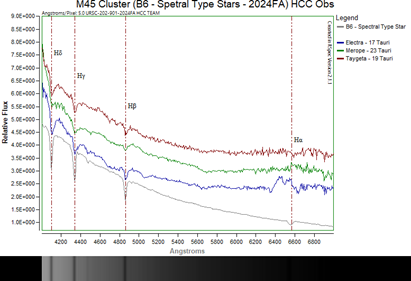
Figure 5: M45 Cluster B6-Spectral Type Stars 2nd Observation
B7 Spectral Type
The spectra of the targeted B7 stars Alcyone (eta Tau, Maia (20 Tau), and Celaeno (16 Tau) were captured on two separate observation sessions shown in (Fig. 6) and (Fig 7.). In both observational data sets Alcyone, Maia, and Celaeno present prominent Balmer series absorption lines Hα at ≈ 6562.81 Å, Hβ at ≈ 4340.71 Å, Hγ at ≈ 4340.71 Å. This is consistent with their classification as B7 spectral type stars. The relative depth and positioning, which is the intensity of the spectral lines compared to a baseline or continuum level, are consistent between both sessions which is expected of stars of similar temperature and composition. The spectra in both observations display a continuum with higher flux levels in the blue shorter wavelength regions of the spectrum, gradually decreasing towards the red end of spectrum. This is consistent with the higher surface temperatures of B7 stars; further validated by the observed effective temperature of Celaeno (16 Tau) from GAIA spectrophotometry of 1.16E+04 which is a surface temperature of ≈ 11,600 K [20].
The second session shows evidence of a slightly noisier baseline and broader scatter in the flux, especially in the continuum. Possible causes could be differences in atmospheric conditions, instrumental sensitivity, or possible calibration inconsistencies between the two observations. The second session presents a noticeable rise in flux in the red region of the spectrum < 6500 Å, this could possibly be due to differences in how the SA 200 spectrograph handled background subtraction or calibration in the second observation. The flux ranges in the second observation also appear to be lower overall, which could indicate differences in normalization or variations in observational sensitivity such as telescope settings or sky transparency. The second observation captured slightly broader absorption lines which could indicate lower spectral resolution or broader instrumental response during the second observation. Contributing factors could be instrumental variability between the sessions, atmospheric conditions, calibration issues, exposure time or signal-to-noise ratio.
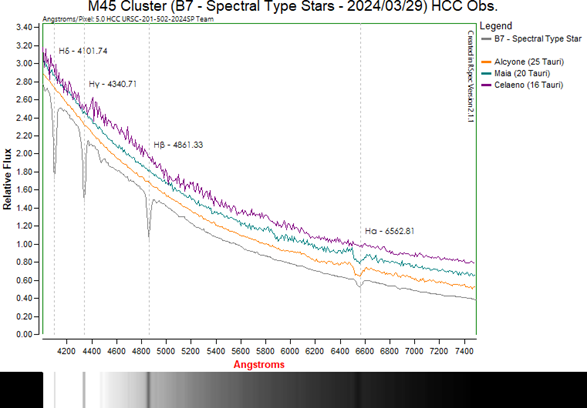
Figure 6: M45 Cluster B7 Spectral Type Stars 1st Observation
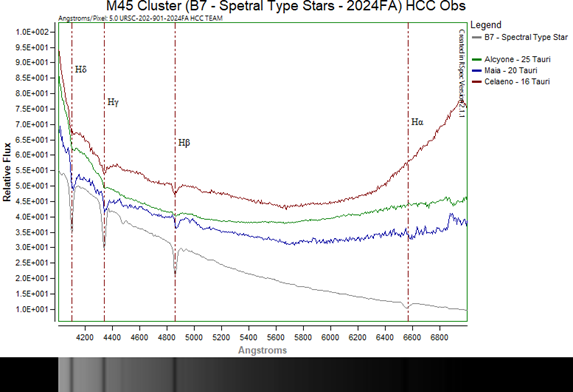
Figure 7: M45 Cluster B7 Spectral Type Stars 2nd Observation
B8 spectral type
The spectra of the targeted B8 stars Atlas (27 Tau), Asterope (21 tau), and Pleione (28 Tau) were captured on two separate observation sessions shown in (Fig. 8) and (Fig. 9). Both observational data sets show prominent Balmer series absorption lines Hα at ≈ 6562.81, Hγ ≈ 4340.71 Å, Hδ at 4101.74 Å which is consistent with B8 stars. The relative positions and depths of the lines remain stable between the two observations. Both observations present a continuum with higher flux in the blue shorter wavelengths that gradually decreases towards the red of the spectrum which is consistent with the high temperatures of B8 stars. The spectral profiles exhibit nearly identical line depths and profiles between the observing sessions, minor variations in continuum flux are within the expected range for observational conditions further supporting the consistency of the spectral characteristics across both sessions. The consistency and robustness of the Balmer absorption lines across both observations confirms Atlas (27 Tau), Asterope (21 tau), and Pleione (28 Tau)’s B8 classification, and presents reliable data for determining properties such as temperature and pressure.
The second observation exhibits smoother flux transitions between ≈ 4800-5000, where the continuum appears more uniform compared to the first session. However, at shorter wavelengths ≈ 4100 Å near Hδ increased noise is present. In the second observation an elevation in flux is observed beyond 6500 Å at the red end of the spectrum. This could be due to calibration discrepancies, background light contamination, or instrument variability. The first observation has relatively consistent noise levels across the spectrum. The second observation displays greater noise variability particularly in the lower flux regions. The absorption lines in the second observation are slightly broader and less distinct than the first observation. This could be due to lower spectral resolution, instrument broadening, atmospheric conditions, detector efficiency, slit alignment, flux normalization, background subtraction technique, exposure times, signal-to-noise rations during the second observation.
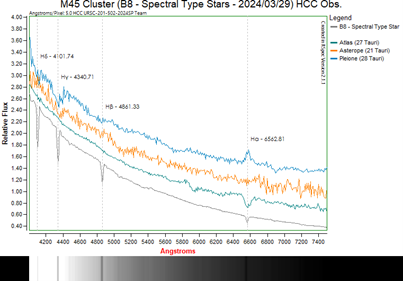
Figure 8: M45 Cluster B8 Spectral Type Stars Observation 1
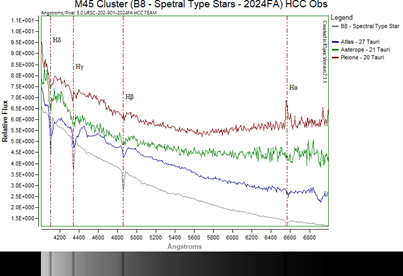
Figure 9: M45 Cluster B8 Spectral Type Stars Observation 2
M45 GAIA Isochrone B-Type Modelling
GAIA DR3 was queried and aggregated to plot a theoretical isochrone curve for M45 shown in (Fig. 10). A theoretical isochrone curve is a model-generated plot that represents the evolutionary state of a population of stars of the same age but different masses. This is used to determine age, metallicity and composition, and distance, qualitative analysis was performed to compare observational data collected and theoretical modelling.
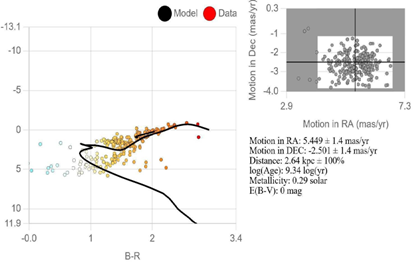
Figure 10: GAIA derived M45 Isochrone Model
The theoretical isochrone model is consistent with previous data about the cosmological age of M45, although presented as slightly older at ~220 million years (Myr) than the current accepted ~100-150 Myr [21]. The Isochrone curve and fitting indicates evidence of a young open-cluster with a statistically significant population in the early-mid MS life stage [22]. The hot (blue) B-type members on the isochrone model in Figure 7 present as a statistical outlier on the isochrone curve, not aligning with the theoretical isochrone fitting [23]. Our findings are consistent with the lack of viable GAIA DR2 and DR3 data of high magnitude stars, as mentioned previously due to over-saturation of GAIA CCD detectors. This effect is especially pronounced to the B7-B8 spectral class of stars, evidenced by the complete exclusion of Alcyone in the GAIA DR3 dataset despite its inclusion in the GAIA DR2 dataset.
The theoretical isochrone models predicted proper motion Right Ascension (RA) which can be thought as the celestial longitude, and 5. 449 ± 1. 4 𝑚𝑎𝑠/𝑦𝑟 Declination (DEC) which can be thought of as the celestial latitude motion − 2. 501 ± 1. 4 𝑚𝑎𝑠/𝑦𝑟 differs significantly from observed proper motion 50. 10 ± 0. 74 𝑚𝑎𝑠/𝑦𝑟. The observation data likely reflects individual stellar motions within M45, observed motion variation is σ = 0. 74 𝑚𝑎𝑠/𝑦𝑟 indicative of stars with very similar motion expected of cluster members. The Model-predicted motion does not match the mean observed proper motion, low-scatter in the observed data values is suggestive of a coherent moving group of stellar members.
Astropy GAIA Calculations
The Astropy GAIA Python workflow referenced in the methods section was used by the authors to calculate ≈ 161 different astronomical data points from 6 out of the 9 targeted stars [24]. This research used GAIA DR3 astrometric and photometric data to computationally analyze the galactic dynamics of these stars which can be referenced in full in the Supplemental Data. The data queried for this research using ADQL directly from GAIA DR3 included ≈ 83 different data points which can be seen in the Virtual Observatory Table (VOT) file in the author’s supplemental data. These ≈ 83 GAIA DR3 points included only RA, DEC, Proper Motion in Declination (PMDEC), Proper Motion in Right Ascension, Radial velocities for 3 out of 6 stars, Parallax and parallax error. Photometric mean magnitudes for G, BP, and RP band, and effective temperature (TEFF) for 3 out of 6 stars. The data in tables 1-6 was selected due to importance in galactic dynamics, and due to space constraints in the display of tabular data.
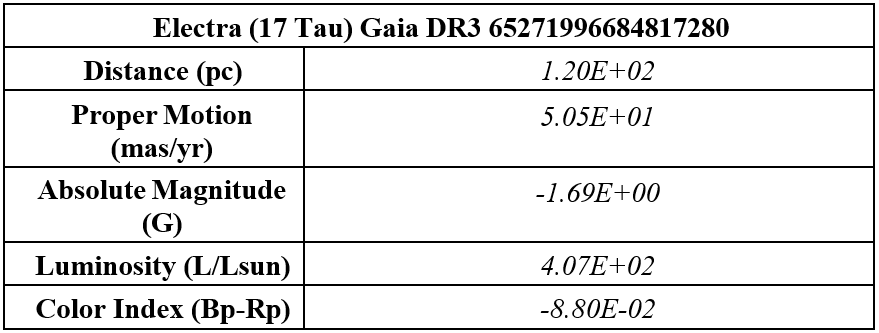
Table 1: Electra (17 Tau) Gaia DR3 65271996684817280

Table 2: Maia (20 Tau) Gaia DR3 65283232316451328
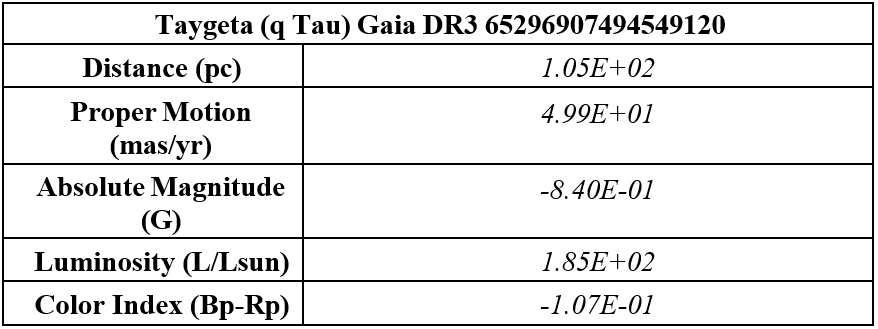
Table 3: Taygeta (q Tau) Gaia DR3 65296907494549120
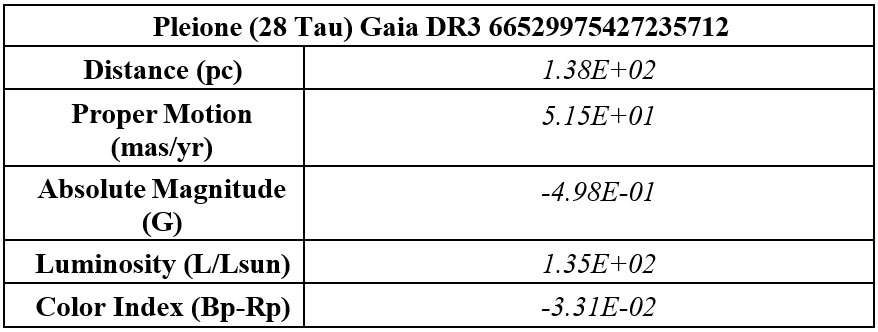
Table 4: Pleione (28 Tau) Gaia DR3 66529975427235712
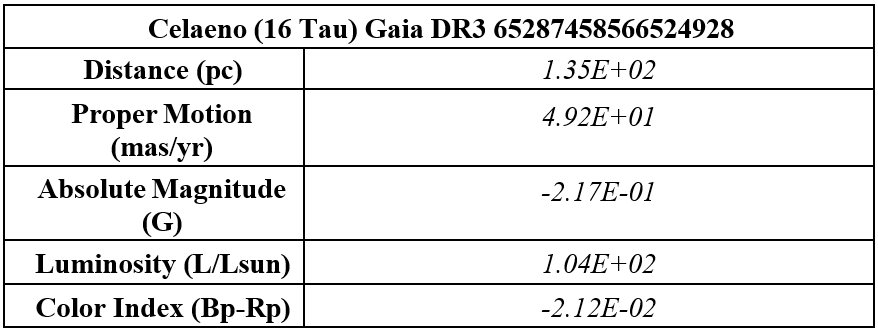
Table 5: Celaeno (16 Tau) Gaia DR3 65287458566524928
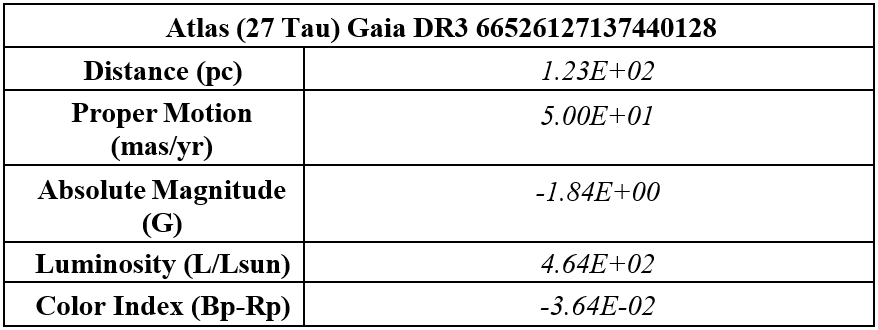
Table 6: Atlas (27 Tau) Gaia DR3 66526127137440128
Electra (17 Tau) results on distance and proper motion agree with published results on SIMBAD, derived luminosity of 407 L☉, and the Color Index (Bp-Rp) of -8.80E-02 is consistent for a B6IIe star [25]. Maia (20 Tau) results on distance and proper motion agree with published results in SIMBAD, the derived luminosity of 414 L☉, and Color Index (Bp-Rp) of -1.38E-02 is consistent for a B7III star. Taygeta (q Tau) results on distance and proper motion agree with published results on SIMBAD, derived luminosity of 185 L☉, and Color Index (Bp-Rp) of -1.07E-01 is consistent for a B6IV star. Atlas (27 Tau) results on distance and proper motion agree with published results on SIMBAD, derived luminosity of 464 L☉, and Color Index (Bp-Rp) -3.64E-02 is consistent for a B8III evolving off the MS.
Celaeno (16 Tau) Gaia DR3 65287458566524928 results on distance and proper motion agree with published results on SIMBAD. The derived luminosity of 104 L☉, and Color Index (Bp-Rp) of -2.12E-02 is consistent for a B7V star. Pleione (28 Tau) Gaia DR3 66529975427235712 results on distance and proper motion agree with published results on SIMBAD, derived luminosity of 104 L☉, and the Color Index (Bp-Rp) of -3.31E-02 is inconsistent for a B8Vne star. Given that Celaeno is a B7V star with a derived luminosity of 104 L☉. The photometric variability of Pleione is well documented in the literature by Tanaka and et al [26], Nemravová and et al [27], Marr and et al [28]. This variability is currently theorized to be attributed to Pleione’s rapid rotation, and a broken BE star disc. The photometric variability observed by Pleione is consistent with previous observations, the exact nature of this observed variability is however beyond the scope of this paper.
Parallax Over Error
Electra (17 Tau) Gaia DR3 65271996684817280 has a published Parallax (mas) of 8.3457. The parallax derived through Astropy is 8.35E+00 mas with parallax over error of 1.90E+01 which is 19.0. Parallax over error < 5.0 has been considered reliable [28]. 6 out of 9 stars observed have parallax over errors indicating high certainty shown in (table 7).

Table 7: Parallax, Parallax Error, and Parallax Over Error
Radial Velocity SIMBAD Discrepancies
The star Merope (23 Tau) Gaia DR3 65205373152172032 has published radial velocity on SIMBAD as 6.2 ± 2.0 (km/s) derived from Wilson (1956), the following radial velocity was calculated through this study for Merope (23 Tau) 4.80E+00 (km/s) [29]. For the star Electra (17 Tau) Gaia DR3 65271996684817280 the published radial velocity on SIMBAD is 6.87 ± 0.72 (km/s) from Torres (2021) [30]. The following radial velocity for Electra (17 Tau) was calculated through this study 4.76E+00 (km/s).
21 & 22 Tau Double Star System Photometrically Resolved
The double star system 21 & 22 Tau was photometrically resolved in our imaging data. The separation between the members is evident in the photometric measurements and is clearly distinguishable in the astrometric solution processed image shown in (Fig. 11).
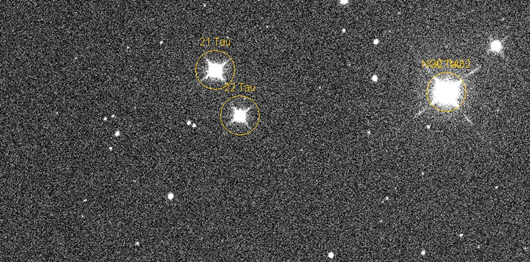
Figure 11: 21 & 22 Tau Double Star System
Discussion
The results of the spectroscopy observations are strong evidence in support of the existing spectral types of the observed B6, B7, and B8 star classifications. The consistency and robustness of Balmer absorption lines across both observation sessions for the B8 stars could possibly provide data to better determine physical properties such as temperature and pressure. Through the measurement of depth and equivalent width (EW) of the Balmer absorption lines, with measurement of line broadening, and effective temperature. EW is a measure used in spectroscopy to quantify the strength of an absorption or emission line in a spectrum that would represent the width of a hypothetical triangular feature. Likewise, pressure and surface gravity could be modelled from the Balmer line wings using stellar atmosphere codes or synthetic spectrum fitting.
The theoretical isochrone models predicted proper motion differing significantly from observed proper motion. The Isochrone curve and fitting provided clear evidence of a young open-cluster with a statistically significant population of stars in the early-mid MS life stage which is consistent with previous observations of M45. However, the model is presenting as slightly older at ~220 Myr than the current accepted ~100-150 Myr. Further modeling and observation of B-type stars in M45 should be conducted to verify effects on cosmological modelling. The authors cannot state with a high degree of confidence whether the isochrone modelling is consistent with the stellar evolution of M45.
Differences in the continuum shape and flux scaling between the first and second observation session may require correction or additional cross-referencing with standard stars or reference spectra. Observed variations in noise and line resolution suggest that additional sessions or increased standardization across observations may be needed to improve data reliability. Additionally, variations in the red wavelength through elevated red flux in the second session may require additional investigation to ensure accurate flux calibration and data consistency for future investigations. A comparison of the observed and expected wavelengths for the Balmer series (Hα, Hγ, Hδ) was conducted on the B6, B7, and B8 spectral type stars. The relative difference between observed and actual values was computed using the following equation:
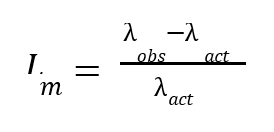
where λ is the measured wavelength and λ is the theoretical laboratory wavelength.
The computed Lm values for all spectral lines were found to be on order of 10-4-10-6, indicating only minor deviations from the expected wavelengths. This suggests that instrumental calibration was well-maintained, and that no significant systematic errors occurred affecting the wavelength measurements. Furthermore, no strong trends in redshift or blueshift were detected across all spectral types. The observed variations could be attributed to instrumental precision limitations stemming from spectrograph calibration drift. Atmospheric effects could have introduced shifts due to the ground-based nature of the observations. The variation could be attributed to Intrinsic stellar motion; however, the small magnitude of the computed Lm values suggest this effect is negligible.
The GAIA Python workflow calculations further provided evidence in support of the current spectral classifications of the 7 stars. Through the consistency of results on distance and proper motion with published results on SIMBAD. The luminosity in L☉ and the Color Index (Bp-Rp) for all 7 stars were calculated and the results appeared consistent with the spectral classification of all 7 stars. Inconsistencies in the observed photometric properties of Pleione were found in our derived luminosity of 104 L☉, and the Color Index (Bp-Rp) of -3.31E-02 which is inconsistent for a B8Vne star providing further evidence of its variability. However, the exact causes of Pleione’s variability are outside of the scope of this research and should be explored further. Furthermore, 6 out of 9 stars observed have parallax over errors indicating high certainty. This research also used Large Language Models Primarily Chat-GPT release 4o to supplement the completion of certain backend tasks such as data analysis and coding.
The calculated radial velocities for Merope (23 Tau) Gaia DR3 65205373152172032 and Electra (17 Tau) Gaia DR3 65271996684817280 differ significantly from previous observations. The age of the observation by Wilson is significant, however the observation by Torres is relatively recent. The following radial velocity was calculated for Merope (23 Tau) Gaia DR3 65205373152172032 to be 4.80 (km/s). The following radial velocity for Electra (17 Tau) Gaia DR3 65271996684817280 was calculated to be 4.76 (km/s).
Conclusion
Given the consistency of the spectroscopy results across the B6, B7, and B8 spectral types, it is concluded that the observed spectral line positions are reliable and do not indicate any significant radial velocity shifts for the 9 observed stars in M45. Future work may involve higher spectral resolution observations, and a broader sample to further confirm these findings. As seasonal weather conditions did not allow observations to be conducted within a close enough window, future observations should aim to conduct the observations in short succession. The following improved radial velocities were calculated for Merope (23 Tau) Gaia DR3 65205373152172032 at 4.80E+00 (km/s) and Electra (17 Tau) Gaia DR3 65271996684817280 at
4.76E+00 (km/s). The theoretical isochrone model predicted proper motion differed significantly from observed proper motions, Astropy and NumPy calculations are consistent with previous observational data.
Acknowledgements
This work has made use of data from the European Space Agency (ESA) mission Gaia (https://www.cosmos.esa.int/gaia), processed by the Gaia Data Processing and Analysis Consortium (DPAC, https://www.cosmos.esa.int/web/gaia/dpac/consortium). Funding for the DPAC has been provided by national institutions, in particular the institutions participating in the Gaia Multilateral Agreement.
This research has made use of the SIMBAD database, operated at the Centre de Données astronomiques de Strasbourg (CDS), Strasbourg, France.
This research made use of R-SPEC software developed by Field Tested Systems LLC The authors would like to acknowledge the assistance and guidance from previous Howard Community College URSC researchers Anjolie Tuazon, Micaela Deugarte, and Valeria Monterroza.
The authors would also like to acknowledge assistance provided by Dr. Brendan Diamond of the Howard Community College URSC program.
Contact: timothy.winans@howardcc.edu, twinans1@umbc.edu, timothyrwinans@gmail.com
References
[1] Sparavigna, A., “The Pleiades: the celestial herd of ancient timekeepers”, arXiv e-prints, Art. no. arXiv:0810.1592, 2008. https://doi.org/10.48550/arXiv.0810.1592.
[2] C. Messier “Connaissance des Temps”, (Paris, 1784).
[3] Rosenberg, H. “Über den Zusammenhang von Helligkeit und Spektraltypus in den Plejaden”, Astronomische Nachrichten, vol.186, no.5, pp.71-78, 1910.
[4] Russell, H. N., “Relations Between the Spectra and Other Characteristics of the Stars”, Popular Astronomy, vol. 22, pp. 275–294, 1914. https://ui.adsabs.harvard.edu/abs/1914PA…..22..331R/abstract.
[5] Kippenhahn, R. and Weigert, A., Stellar Structure and Evolution. 1990, p. 192. https://ui.adsabs.harvard.edu/abs/1990sse..book…..K/abstract.
[6] T. Constantino, I. Baraffe, T. Goffrey, J. Pratt, T. Guillet, D. G. Vlaykov, and L. Amard, “Suppression of lithium depletion in young low-mass stars from fast rotation,” Astronomy & Astrophysics, vol. 654, p. A146, 2021. [Online]. https://doi.org/10.1051/0004-6361/202141402.
[7] Melis, C., Reid, M. J., Mioduszewski, A. J., Stauffer, J. R., and Bower, G. C., “A VLBI resolution of the Pleiades distance controversy”, Science, vol. 345, no. 6200, pp. 1029–1032, 2014. https://ui.adsabs.harvard.edu/link_gateway/2014Sci…345.1029M/doi:10.1126/science.1256 101
[8] Schwarzschild, M., Structure and evolution of the stars. 1958. http://www.jstor.org/stable/j.ctt183pq2p.
[9] W. S. Boyle and G. E. Smith, “Charge coupled semiconductor devices”, in The Bell System Technical Journal, vol. 49, no. 4, pp. 587-593, April 1970, https://doi.org/10.1002/j.1538-7305.1970.tb01790.x.
[10] Dodd, W., “What is Sidereal Time and What Is It Good For?”, Journal of the Royal Astronomical Society of Canada, vol. 97, no. 6, p. 278, 2003. https://articles.adsabs.harvard.edu/pdf/2003JRASC..97..278D.
[11] Labiano, A, et al., “Wavelength calibration and resolving power of the JWST MIRI Medium Resolution Spectrometer”, Astron. Astrophys. Vol. 656, pp. 1-14, 2021, https://ui.adsabs.harvard.edu/link_gateway/2021A&A…656A..57L/doi:10.1051/0004-6361/ 202140614
[12] Baum, S. et al., 1996, “STIS Instrument Handbook”, Version 1.0 (Baltimore: STScI). https://www.eso.org/~amicol/HST/stis_ihb_all.pdf.
[13] B. W. Carroll and D. A. Ostlie, An Introduction to Modern Astrophysics, 2nd ed. Cambridge, UK: Cambridge University Press, 2017. https://doi.org/10.1017/9781108380980.
[14] GIMP Development Team, GIMP: GNU Image Manipulation Program, Version 2.10, GIMP.org, 2025. [Software]
[15] Field, T., “A Survey of Current Amateur Spectroscopic Activies, Capabilities and Tools”, Society for Astronomical Sciences Annual Symposium, vol. 33, pp. 131–138, 2014. https://ui.adsabs.harvard.edu/abs/2014SASS…33..131F/abstract.
[16] Astropy Collaboration, “The Astropy Project: Sustaining and Growing a Community-oriented Open-source Project and the Latest Major Release (v5.0) of the Core Package”, The Astrophysical Journal, vol. 935, no. 2, Art. no. 167, IOP, 2022. https://ui.adsabs.harvard.edu/link_gateway/2022ApJ…935..167A/doi:10.3847/1538-4357/a c7c74.
[17] Astroquery Development Team, Astroquery: Python tools for querying astronomical databases, Documentation, [Online]. Available: https://astroquery.readthedocs.io/en/latest/.
[18] Lang, D. W. Hogg, K. Mierle, M. Blanton, and S. Roweis, “Astrometry.net: Blind astrometric calibration of arbitrary astronomical images,” Astronomical Journal, vol. 139, no. 5, pp. 1782-1795, Mar. 2010, http://dx.doi.org/10.1088/0004-6256/139/5/1782.
[19] Kinney, A. L., Bohlin, R. C., Calzetti, D., Panagia, N., and Wyse, R. F. G., “An Atlas of Ultraviolet Spectra of Star-forming Galaxies”, The Astrophysical Journal Supplement Series, vol. 86, IOP, p. 5, 1993. https://ui.adsabs.harvard.edu/link_gateway/1993ApJS…86. 5K/doi:10.1086/191771
[20] Gaia Collaboration, A. Vallenari, A. G. A. Brown, T. Prusti, J. H. J. de Bruijne, F. Arenou, C. Babusiaux, et al., “Gaia Data Release 3: Summary of the Content and Survey Properties,” Astronomy & Astrophysics, vol. 674, Art. no. A1, June 2023, https://doi.org/10.1051/0004-6361/202243940.
[21] S. Gossage, C. Conroy, A. Dotter, J. Choi, P. Rosenfield, P. Cargile, and A. Dolphin, “Age Determinations of the Hyades, Praesepe, and Pleiades via MESA Models with Rotation,” The Astrophysical Journal, vol. 863, no. 1, p. 67, Aug. 2018, https://doi.org/10.3847/1538-4357/aad0a0
[22] Fritzewski, D. J., Barnes, S. A., James, D. J., and Strassmeier, K. G., “The rotation period distribution of the rich Pleiades-age southern open cluster NGC 2516. Existence of a representative zero-age main sequence distribution”, Astronomy and Astrophysics, vol. 641, Art. no. A51, 2020. https://doi.org/10.1051/0004-6361/201936860
[23] Hazlehurst, J. and Thomas, H.-C., “Stellar rotation and the age of the Pleiades”, Monthly Notices of the Royal Astronomical Society, vol. 150, OUP, p. 311, 1970. https://ui.adsabs.harvard.edu/link_gateway/1970MNRAS.150..311H/doi:10.1093/mnras/15 0.3.311
[24] C. R. Harris, K. J. Millman, S. J. van der Walt, et al., “Array programming with NumPy,” Nature, vol. 585, pp. 357–362, Sep. 2020. https://doi.org/10.1038/s41586-020-2649-2
[25] Wenger, et al., “The SIMBAD astronomical database. The CDS reference database for astronomical objects”, Astronomy and Astrophysics Supplement Series, vol. 143, 9–22, 2000. https://ui.adsabs.harvard.edu/link_gateway/2000A&AS..143. 9W/doi:10.1051/aas:2000332
[26] Tanaka, K. Sadakane, S. Narusawa, H. Naito, E. Kambe, J. Katahira, and R. Hirata, “Dramatic Spectral and Photometric Changes of Pleione (28 Tau) between 2005 November and 2007 April,” Publ. Astron. Soc. Jpn., vol. 59, no. 4, pp. L35–L39, Aug. 2007, https://doi.org/10.1093/pasj/59. 4.L35
[27] Nemravová, , “Properties and nature of Be stars. 27. Orbital and recent long-term variations of the Pleiades Be star Pleione = BU Tauri”, Astronomy and Astrophysics, vol. 516, Art. no. A80, 2010. https://doi.org/10.1051/0004-6361/200913885
[28] C. Marr, C. E. Jones, C. Tycner, A. C. Carciofi, and A. C. Fonseca Silva, “The Role of Disk Tearing and Precession in the Observed Variability of Pleione,” The Astrophysical Journal, vol. 929, no. 2, p. 150, Apr. 2022, https://ui.adsabs.harvard.edu/link_gateway/2022ApJ…928..145M/doi:10.3847/1538-4357/a c551b
[28] Lutz, E. and Kelker, D. H., “On the Use of Trigonometric Parallaxes for the Calibration of Luminosity Systems: Theory”, Publications of the Astronomical Society of the Pacific, vol. 85, no. 507, IOP, p. 573, 1973. https://iopscience.iop.org/article/10.1086/129506#artAbst
[29] Wilson, E., “General catalogue of stellar radial velocities.”, Carnegie Institute Washington D.C. Publication, p. 0, 1953. https://ui.adsabs.harvard.edu/abs/1953GCRV..C. 0W/abstract
[30] Torres, G., Latham, D. W., and Quinn, S. N., “Long-term Spectroscopic Survey of the Pleiades Cluster: The Binary Population”, The Astrophysical Journal, 921, no. 2, Art. no. 117, IOP, 2021. https://ui.adsabs.harvard.edu/link_gateway/2021ApJ…921..117T/doi:10.3847/1538-4357/ac 1585
